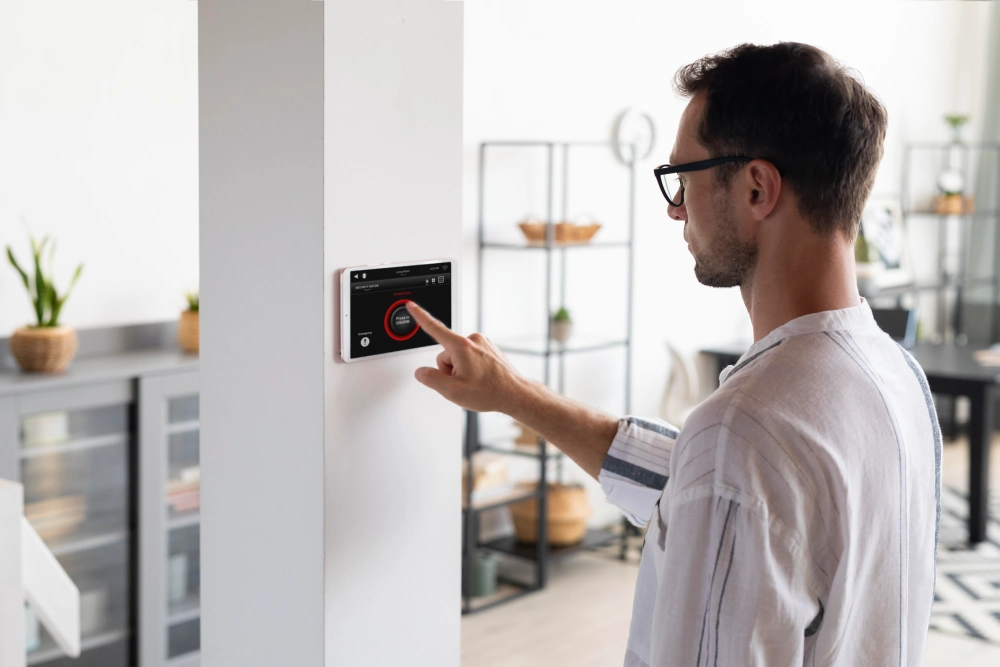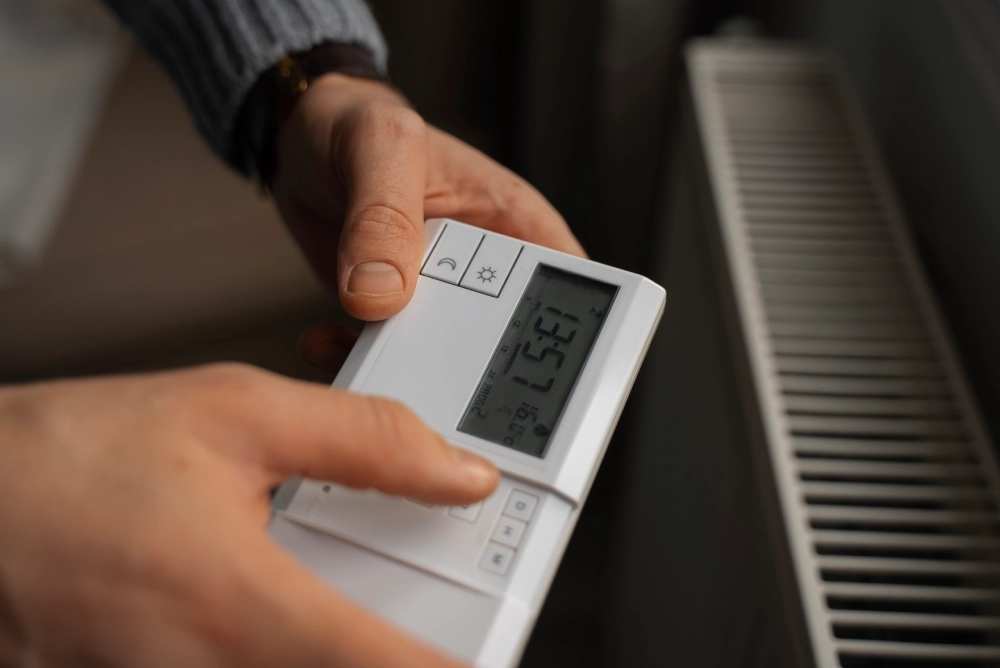In the heart of winter or during a sudden cold snap, the importance of a reliable heating system becomes undeniably clear. Among the features that ensure our spaces remain warm and comfortable is an emergency heat setting on the thermostat. This setting plays a crucial role during extremely cold temperatures or when the main heat pump struggles to maintain the desired indoor temperature..
Understanding and mastering the emergency heat setting on the thermostat can save you from chilly discomfort and ensure your heating system operates when you need it most. This guide will help you become proficient in using the emergency heat setting on the thermostat.
What is Emergency Heat?
Emergency heat, often labeled as “EM heat” on your thermostat, is a secondary heating system designed to supplement your primary heat pump. It’s typically used in two scenarios: when the outside temperature is too cold for your heat pump to operate efficiently or if your heat pump malfunctions.
The emergency heat setting on the thermostat activates a backup heating system, which can be electric resistance heaters, gas, oil, or other forms of heating, depending on your setup. This setting bypasses the heat pump, allowing the secondary source of heat to take over and maintain warmth.
When to Use Emergency Heat Setting on Thermostat
Understanding the best times to utilize the emergency heat function on a thermostat is essential for maximizing its performance and keeping surroundings warm and comfortable. Let’s explore deeper into the scenarios that warrant the use of emergency heat:
• Heat Pump Malfunction
The reliability of your primary heating system is crucial during cold months. However, if you encounter a malfunction where your heat pump ceases to work correctly, the emergency heat setting on the thermostat acts as a crucial backup. This setting ensures that you continue to receive warmth, bridging the gap until repairs can be made. It’s a temporary solution that guarantees your comfort isn’t compromised while awaiting professional assistance.
• Extremely Cold Weather
Heat pumps are designed to draw heat from the outside air and transfer it indoors. Yet, when temperatures drop to extreme lows, the efficiency of a heat pump can significantly decrease, struggling to provide adequate heating. In such conditions, relying on the emergency heat setting on the thermostat can offer the necessary warmth. It’s an effective way to supplement your primary heating system, ensuring that your indoor environment remains comfortable, even in the harshest winter weather.
• Ice or Snow Buildup
Winter weather can bring about ice and snow accumulation, which may obstruct the outdoor unit of your heat pump. This blockage hampers the system’s ability to function efficiently, potentially leading to damage or reduced heating capability. Activating the emergency heat setting on the thermostat allows your space to stay warm while you address the removal of ice or snow. It’s important to clear these obstructions safely and promptly to restore your heat pump’s functionality and prevent long-term damage.
Tips for Efficient Use of Emergency Heat Setting on Your Thermostat

Maximizing the efficiency of your emergency heat setting on the thermostat not only ensures your home and office stay warm but also helps manage your energy bills. Here are additional nuanced tips to help you navigate the balance between comfort and cost-effectively:
1. Boost Insulation
One of the most effective ways to reduce the need for emergency heat is by enhancing your insulation. Well-insulated attics, walls, and floors can keep the warmth inside and the cold outside, making your heating system’s job easier and more efficient. Think about conducting an energy audit to identify areas where insulation can be improved.
2. Seal Windows and Doors
Drafts around windows and doors can significantly affect your home or office’s warmth. Sealing these gaps using weather stripping or caulking can prevent cold air from getting in and warm air from escaping. This simple measure can make a noticeable difference in your space’s temperature and reduce the reliance on emergency heat.
3. Invest in a Smart Thermostat
Smart thermostats can optimize your heating system’s efficiency by adapting to your schedule and adjusting the temperature accordingly. They can reduce the need for emergency heat by ensuring your home is only heated when necessary and maintaining a more consistent temperature.
4. Utilize Programmable Settings
If you have a programmable thermostat, set it to lower the temperature when you’re not home and warm up the house before you return. This prevents the system from using emergency heat to rapidly warm a cold house, which is less efficient and more costly.
5. Use Space Heaters Wisely
In situations where only a portion of your home or office needs to be heated, consider using space heaters instead of switching to emergency heat. This can be particularly effective in well-insulated rooms or during short periods. Always follow safety guidelines when using space heaters to prevent fire hazards.
6. Professional Inspection
It is advisable to have a professional inspect your heat pump annually, particularly before the onset of cold weather. This inspection can ensure that your system is prepared to handle the winter efficiently, potentially avoiding the need for emergency heat.
7. Prepare for Cold Weather in Advance
Before the cold season begins, take steps to prepare your home or office and heating system. This includes checking your insulation, sealing drafts, and scheduling maintenance. Being proactive can reduce the likelihood of needing emergency heat and ensure your space stays comfortable throughout the winter.
How to Use the Emergency Heat Setting on Your Thermostat
Mastering the emergency heat setting on the thermostat involves more than knowing when to turn it on. These are step-by-step instructions to help you navigate this feature confidently, ensuring that you can utilize it optimally to maintain warmth and comfort in your home.
Step 1: Locate the Emergency Heat Mode
The emergency heat setting on the thermostat is typically labeled as “EM Heat” or “Emergency.” Spend some time exploring your thermostat’s interface, whether it’s a dial, digital panel, or controlled via an app. If you’re unsure, refer to the manual for guidance.
Step 2: Activate the Setting
When needed, switch your emergency heat setting on the thermostat. First, identify situations like a malfunctioning heat pump or extreme cold. Then, locate the switch or button for emergency heat. On digital or smart thermostats, this may involve navigating menus. Activate the emergency heat mode by selecting “EM Heat” or a similar option.
Step 3: Monitor Your Space Temperature
Keep an eye on your indoor temperature while using emergency heat. Emergency heat sources may heat your home or office differently, so watch how quickly your space reaches the desired temperature. Use a separate thermometer to verify room temperatures if needed. Be aware of areas that may not receive adequate heat and consider adjustments for comfort.
Step 4: Switch Back to Normal Mode
Once the need for emergency heat subsides, switch your system back to its regular heating mode. Return the thermostat setting from “EM Heat” or “Emergency” to standard heating mode. Monitor your heat pump’s performance to ensure it’s efficiently warming your home. Consider scheduling a maintenance check-up if your heat pump is malfunctioning.
Emergency Heat Setting on the Thermostat FAQ’s
Can I leave the emergency heat setting on all the time?
It’s not recommended to leave the emergency heat setting on continuously unless there’s a specific need, such as a prolonged period of extreme cold or if your primary heating system is non-functional. Continuous use of the emergency heat setting can lead to greater energy consumption and increased utility bills.
Is there a difference between emergency heat and auxiliary heat?
While the terms are often used interchangeably, there can be slight differences depending on the heating system. Emergency heat typically refers to a backup heating system that activates when the primary heating system fails. Auxiliary heat, on the other hand, is an additional heat source used to supplement the primary heating system.
Will using emergency heat affect the lifespan of my heating system?
Prolonged or frequent use of emergency heat can potentially impact the lifespan of your heating system, particularly if it relies on electric resistance heating, which consumes more energy and may lead to increased wear on components. Additionally, using emergency heat excessively may cause the backup heating system to work harder than normal, potentially accelerating wear and reducing its overall lifespan.
Conclusion
The emergency heat setting on the thermostat is a vital feature for those cold days when the primary heating system isn’t enough. Remember, emergency heat is designed for specific situations and should be used carefully to avoid high energy bills. If you find yourself frequently relying on emergency heat, it may indicate a problem with your primary heating system that needs professional attention.
Tropic Air-Conditioning Inc. is committed to ensuring your HVAC system functions at peak efficiency, delivering warmth and comfort throughout the winter season. If you need more information on maintaining your heating system or require professional HVAC services, contact us today.




